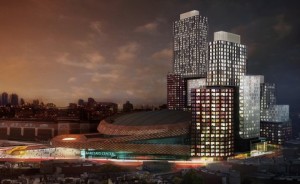Sheldon Silver may have had just one vote, but a “no” from him carried more weight than any other politician in the state legislature. For developers, it could be the kiss of death.
The former state Assembly speaker — who was recently convicted on federal corruption charges involving $4 million in kickbacks — was one of the three most powerful men in Albany, along with the governor and Senate majority leader. (The last two Senate majority leaders were also convicted on corruption charges.)
On the heels of Silver’s downfall, experts are left to dissect his nearly 40-year track record. In terms of real estate, he will likely go down as one of the most influential politicians to have shaped the city — from vetoing the controversial West Side stadium proposal to shepherding through approval of millions of dollars in 421a tax breaks for the mega towers along Billionaire’s Row.
“His legacy is so big, it’s almost unimaginable,” said Zephyr Teachout, a political scholar at Fordham University who lost New York’s Democratic Party gubernatorial nomination to Gov. Andrew Cuomo in 2014.
Some have even argued that Silver’s guilty verdict forever casts a shadow on the developments that were erected (or torpedoed) under his tenure.
“When you look at one of these projects when they’re built and successful, you’ll wonder, ‘What did he get in return for supporting that?’” said David Birdsell, dean of the Baruch College School of Public Affairs.
Whether Albany will finally pass an ethics reform package with teeth remains to be seen, but some lawmakers are trying.
In December, a group of five Senate Democrats, including Democratic Minority Leader Andrea Stewart-Cousins of Yonkers, said they would introduce a bill banning lawmakers from accepting outside income from private companies. Others have suggested simply strengthening income-disclosure requirements.
But it’s not just lawmakers who are likely to shift their behavior. Terry Oved, a real estate attorney at Oved & Oved, speculated that developers might be more cautious in their dealings with political power brokers.
“Many may try to minimize their direct contact with these people, whether innocent or not, if only to prevent themselves from becoming embroiled in these scandals,” he said. “It’s guilt by association. If their names get associated with something like this, it may impact their ability to retain and attract investors to their projects.”
The last thing the industry wants is to become “another Wall Street,” he added.
Some say New York should alter the landscape so that the state does not coronate another politician with as much power as Sheldon Silver amassed.
Birdsell said one way to radically alter how business is conducted in Albany would be to limit the power of top officials to override approval of a project. “When it’s a case that one individual controls the whole agenda of a body, there’s a problem,” he said. “By disseminating the power more broadly, you limit the possibility of corruption.”
But such change is unlikely, he added, because it requires approval from the very people whose power it is seeking to restrict.
Over the years, Silver’s decisive say on many of New York City’s real estate projects was no secret — nor were the allegations of corruption and backroom deals. This month, The Real Deal took a look at some of the significant developments that Silver either prevented or helped make happen. All could have been big turning points
for the city.
The West Side stadium
Mayor Michael Bloomberg spent nearly four years assembling a $2.2 billion plan to build a football stadium on the Far West Side for the New York Jets. The administration argued the benefits were twofold: A stadium could spur much-needed redevelopment in the neighborhood and help the city win a bid to host the 2012 Olympics. While there was much opposition to the proposal, the mayor failed to persuade the one who arguably mattered most — Silver, who sat on the state’s Public Authorities Control Board, along with Gov. George Pataki and Senate Majority Leader Joseph Bruno.
In 2005, Silver cast his veto on the stadium plan, saying that it would undermine the redevelopment of his Lower Manhattan district. (Bruno also voted against it but was open to compromise.)
 “On the Jets stadium, I said no, all by myself,” Silver told New York magazine in 2008. “It wasn’t an issue before the legislature, and it didn’t make sense. To put a football stadium on the West Side? And spend billions in taxpayer money? The fans didn’t even want it.”
“On the Jets stadium, I said no, all by myself,” Silver told New York magazine in 2008. “It wasn’t an issue before the legislature, and it didn’t make sense. To put a football stadium on the West Side? And spend billions in taxpayer money? The fans didn’t even want it.”
Bloomberg, who was reported as being furious at Silver, said the delay in development would “be measured in years, not months.”
In 2008, early in the recession, the Related Companies was tapped to develop the 26-acre site. The project, now known as Hudson Yards, broke ground in 2012.
Moynihan Station
In 2006, Silver delivered a major setback to Related and Vornado Realty Trust by vetoing the team’s initial proposal for Moynihan Station.

Moynihan Station
The $900 million plan would have expanded Penn Station across Eighth Avenue into the James A. Farley Post Office. Silver voted against the project despite near-unanimous support from other elected officials.
“Speaker Silver has single-handily prevented the most important civic and transportation project in the nation today from proceeding,” Pataki said at the time.
The board later approved revised plans in 2010 but the transportation and retail hub still has not been realized, largely because Related and Vornado have not managed to secure a tenant for the post office space. Negotiations with a community college and CBS never materialized into a deal.
Just last month, Gov. Cuomo threatened to remove Related and Vornado as the developers of the project unless they begin to make significant progress.
Seward Park
For decades, Silver resisted the redevelopment of the abandoned 20-acre Seward Park area in his own Lower East Side district. He argued that the site was more suitable for a commercial development, such as a big box store, than for affordable housing, an idea proposed by the Koch administration in the 1980s. Silver argued that the diverse ethnic communities represented within his district were simply too divided over the housing plans to proceed.
The speaker took heat for his position from local leaders and housing advocates who accused him of opposing affordable housing to preserve his voter base in the largely Jewish neighborhood by keeping out other groups.
“They would rather have the vacant lots and rats than have minority people there,” Francis Goldin, of the Lower East Side Joint Planning Council, told the New York Times in 1994.
The Seward Park renewal project finally got underway in 2013. A joint venture between L+M Development Partners, BFC Partners and Taconic Investment Partners is spearheading the 1.65-million-square-foot project, which will include 1,000 units of housing, half of which will be affordable.
Atlantic Yards

A rendering of Atlantic Yards
Silver wasn’t always a naysayer. In 2006, he was critical in approving Forest City Ratner’s Atlantic Yards project in Brooklyn and reportedly helped developer Bruce Ratner score an eleventh-hour tax break for the project. The State Assembly in 2007 voted to allow Forest City to take advantage of the controversial 421a program, which gives tax abatements to developers who make 20 percent of their building’s units affordable, even though Ratner didn’t technically qualify.
A special provision was added for Forest City, which allowed the affordable requirement to apply in the aggregate to the project’s 16 buildings, meaning some of the buildings benefitting would be luxury condos.
One affordable housing advocate estimated the deal cost taxpayers $100 million. At the time, an unnamed source fingered Silver as the main culprit. In its 2014 story about Silver’s role in blocking affordable housing on the Lower East Side, the New York Times cited intervention “by Mr. Silver and others” in helping Forest City get the tax break.

A conceptual rendering of Billionaires Row (Credit: Visualhouse)
Billionaire’s Row
Silver has also been viewed as instrumental in securing tax breaks for Billionaire’s Row skyscrapers such as One57 in return for affordable housing being built offsite.
In a 2013 Daily News story, sources accused Silver of quietly slipping the tax breaks for five real estate developers into an otherwise noncontroversial 2013 housing bill that was designed to renew tax abatements for co-op and condo owners and expand protections for tenants of loft buildings.
He has since been criticized for his support of a program that some deem an ineffective way of creating low-cost housing. Tax breaks at One57 cost the city $65.6 million in property tax revenue, for instance, while creating just 66 affordable housing units in the Bronx, according to a recent report from the city’s Independent Budget Office.
“Every time I look up at One57, I see a big middle finger just saying to the city, ‘We don’t care about you,’” Teachout said.
